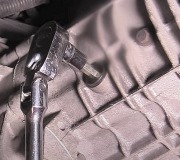You might as well give up right now and put the "For Sale As Is" sign back in the window. Before 2002, many computer modules could indeed have revised software installed, but that was to address minor glitches that affected emissions or driveability issues, not major drive train modifications.
There were computer controls involved with the automatic transmission, and that includes differences in the engine computer and its wiring harness, the output circuits it is expecting to see, the instrument cluster, and possibly the body computer. While I understand the frustration all these unnecessary and complicated computer controls can cause, popping in a manual transmission is not the way to solve those problems. You are better off looking at this as an opportunity to find and buy what you want the way it was built by the manufacturer. As long as there are missing sensors, solenoids, and pressure switches, the computers are going to continue to detect that and set related diagnostic fault codes that you will never solve.
There are two major problems with setting those fault codes. First of all, the computers continually run hundreds of self-tests, some all the time, and some at various times. When a problem is detected, there is always a long list of conditions that must be met for the computer to set the fault code. One of those conditions is that certain other codes are not already set. This applies when the computer determines there is a problem by comparing two or three things to each other to know when one is wrong. If what it compares a defective condition to has already been determined to have a problem, it knows it cannot use that for reference, so any tests that need that reference are suspended. A minor problem that could turn expensive if ignored will never be detected, and you will not know about it until it is too late. This is where when people wait a long time to have a problem diagnosed and repaired, there is plenty of time for additional problems to develop that no one knows about, that is, until the first one is solved, then the self-tests resume, and the new problems are found. The check engine light might turn right back on again, but this time the fault codes are pointing to a totally different problem. This is frustrating for mechanics because they have to tell you more tests and/or parts are needed, and it is frustrating for owners because they incorrectly assume the problem was not diagnosed correctly or repaired correctly.
The second issue is of the more than 2,000 diagnostic fault codes the engine computer can set, about half of them refer to things that could adversely affect emissions. Those are the codes that turn on the check engine light. Even if you know the fault codes that are currently causing the light to be on, you will never know if a different, potentially serious problem develops because the light is already on and you are ignoring it.
One of those defects is going to have to do, for example, with the automatic transmission's lock-up torque converter. It is not there any more, and the computer will detect the open circuit to the solenoid that controlled that valve. All the computer knows is it cannot apply that lock-up clutch, and its entire purpose is to increase fuel mileage. Using more fuel means more tail pipe emissions, and that is what will turn on the check engine light. The same thing can happen if the computer does not see a solenoid in the circuit that runs the overdrive clutch. Being stuck in a lower gear increases emissions. You could spend the rest of your life trying to think of ways to trick the computers into thinking all those missing circuits are working.
As a former suspension and alignment specialist at a very nice family-owned new-car dealership, I had the owner's approval to refuse to work on lifted trucks and lowered cars, even for things totally unrelated to suspension ride height. We all understood the legal and safety ramifications those modifications had that adversely affected braking distance, steering response, handling, and drive line wear. None of us wanted to risk becoming party to any future lawsuit even when the work we did had nothing to with those modifications. I can explain the risks you are taking and the damage taking place to the truck if you want me to, but you did not ask about that. Typing that explanation takes me about two hours. I can sum it up that you can become involved in a lawsuit when its the other guy who ran the red light and caused the crash. His lawyer or insurance investigator will convince a jury that you were partly at fault because you were less able to avoid the crash, and they will be right. I would rather have you pedal the truck and avoid all the problems you are going to encounter. I now that is not what you wanted to hear, but there really are no good solutions for your question.
SPONSORED LINKS
Friday, December 8th, 2017 AT 2:21 PM



